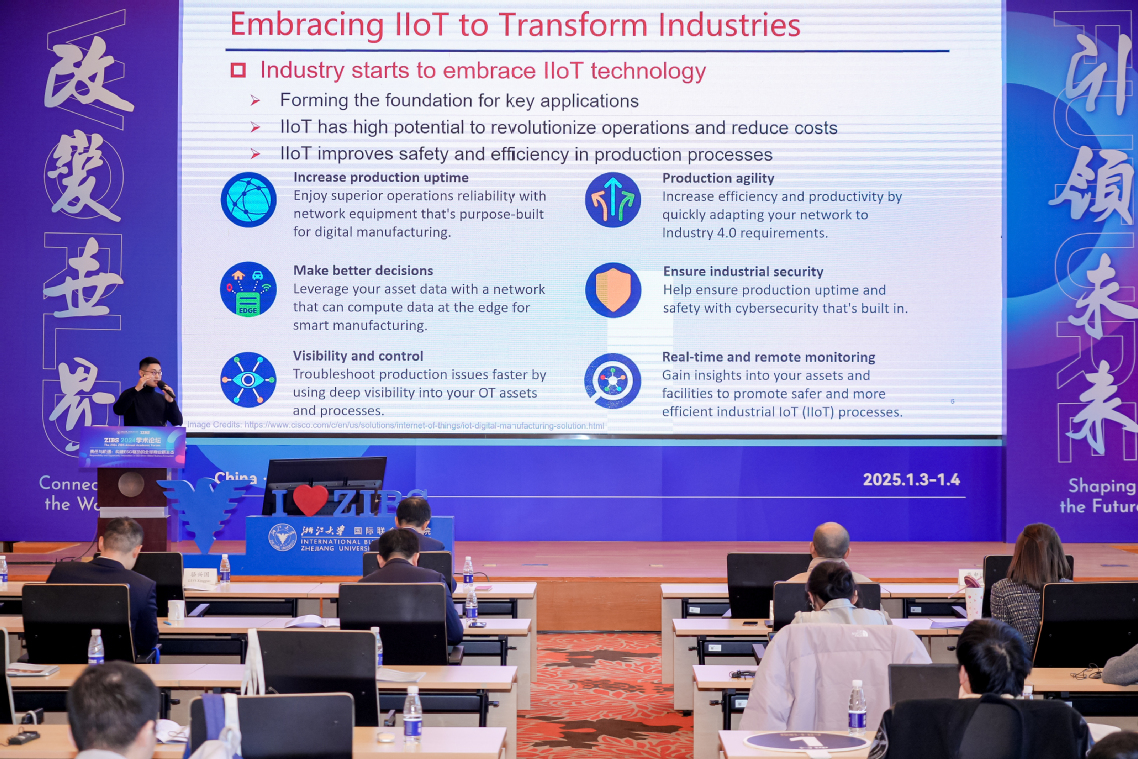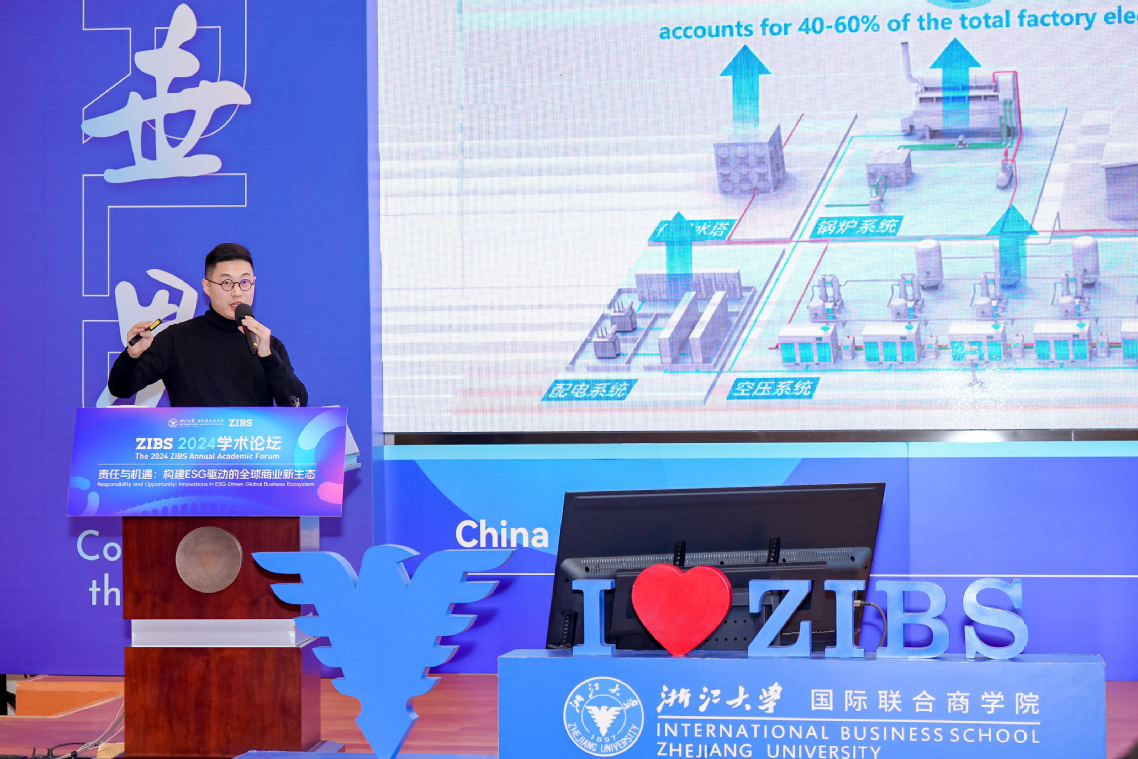At the beginning of January, the 2024 ZIBS Annual Academic Forum, themed Responsibility and Opportunity: Building an ESG-Driven Global Business Ecosystem, was successfully held in the International Campus. The forum delved into cutting-edge topics such as data intelligence, environmental science, fintech, digital innovation, and corporate renewal. It aimed to share the latest research findings, innovative ideas, and practical experiences, offering profound insights and strategies for the sustainable development of global business, technology, and education.
This issue of the ZIBS Insights spotlights the speech delivered by LI Chao, ZIBS Haina Research Scientist. He discussed leveraging IIoT for sustainable industrial energy use. Below is a summary of the key points.

The Rise of IoT in Industrial Sectors
In recent years, there's a growing influence in the integration of the Internet of Things (IoT) reverse aspects in Europe and the industrial sectors. IoT technologies help improve processes, lower costs, and support sustainable practices. The Industrial Internet of Things (IoT) is leading this change by improving industrial performance by optimizing value chains across research, production, supply, sales, and services.
IoT has become an important tool for innovation in industries, allowing for real-time monitoring, data-driven decisions, and better operations. For example, factories use IoT systems to create digital twins, which collect and analyse live data from operations to make quick decisions. The integration of AI and IoT is already making a big difference in many industries, such as:
Cisco: Developed solutions for railway infrastructure, improving operational efficiency through connected systems like Wi-Fi and ultra-wideband (UWB) detection;
Alibaba: Implemented digital platforms, enhancing industrial device management through comprehensive lifecycle monitoring;
Huawei: Launched AirEngine series Wi-Fi products, which offer seamless wireless connectivity, integrating diverse devices into a unified cloud-based ecosystem for data analysis and decision-making.
As environmental sustainability is a pressing global concern, industries are turning to technologies like IoT to improve energy efficiency and help reach carbon neutrality.

The Challenge: Industrial Power Sectors and Energy Efficiency
Industrial Power Sectors (IPS), also referred to as utility sectors, are essential for manufacturing as they provide key resources like electricity, gas, water, air conditioning, and heating. Studies show that IPS can make up 40–60% of a factory's total energy use, making it a key area for energy efficiency improvements.
Energy-intensive devices within IPS, such as air compressors, water pumps, and cooling systems, operate continuously to ensure uninterrupted industrial processes. This energy demand highlights the need for improved efficiency to reduce waste for better sustainability.
Despite their importance, existing IPS often face inefficiencies due to oversupply of energy, which are implemented to ensure uninterrupted operations but inadvertently result in energy waste. For instance, air compressors are often over-supplied, using more energy than required for tasks like painting, spraying, and semiconductor manufacturing. To mitigate this, real-time data monitoring and smart automation are crucial. However, many factories still rely on manual controls, which cause synchronization issues and inconsistencies issues in how device operates, making it harder to manage energy use effectively.

The Solution: Data-Driven Approach in Device Control and Energy Saving
To overcome existing challenges in IPS, a data-driven approach is essential. Traditional manual methods and programmable logic controllers (PLCs) are slow and prone to mistakes. A practical solution should help industries achieve:
Universality: Compatibility across diverse sectors and devices;
Adaptability: Tailored control strategies to meet specific operational needs;
Cost-Effectiveness: Reduced operational costs through efficient resource management.
By integrating AI and IoT technologies as a solution, the process involves:
Data Collection: Gathering real-time data on things like pressure, temperature, and vibration from heterogeneous devices. Reliable communication technologies, such as low-power wireless networks, ensure seamless data integration.
Demand Prediction: Using machine learning models to analyse cycle, consumption, and load forecasting to predict energy demands accurately.
Energy-Saving Control: Implementing sequential decision-making processes, such as reinforcement learning, to optimize device operation and minimize energy waste.
Scalability: Scaling IoT-enabled systems from individual devices to group-level operations for more efficiency. For instance, centralized control of air compressors across a factory can balance supply and demand dynamically, reducing energy consumption and carbon emissions.
Conclusion
IoT technologies hold immense potential to transform power centre design and applications in industrial sectors. By addressing inefficiencies and integrating AI-driven solutions, industries can achieve substantial energy savings and carbon reductions. To summarize the discussion, we first learned the ability of IoT to reduce power consumption and carbon emissions significantly, then we look on at the transformative impact of AI and IoT integration on industrial operations, and lastly, how various devices has now incorporated with these current technologies to create better solutions. As industries aim to improve efficiency while protecting the environment, IoT technologies are an essential tool to achieve these goals.
*This article is based on the speech made by LI Chao at 2024 ZIBS Academic Forum. The views and opinions expressed in this article are those of the speaker and do not necessarily reflect the views or positions of ZIBS.
LI Chao is currently a Haina Research Scientist and Doctoral Supervisor at ZIBS. He obtained his BSc (2012) and PhD (2019) degrees from Zhejiang University. He spent 4 years at the College of Control Science and Engineering as a research assistant at Zhejiang University. His primary research interests include data mining and its applications in smart city and industrial intelligence. His work has been published in leading academic journals such as IEEE TITS, TMC, TCSS, National Science Open and Communications Physics, among others. He has led the National Natural Science Youth Project, and Young Talent Research Project of State Key Laboratory of Industrial Control Technology.




